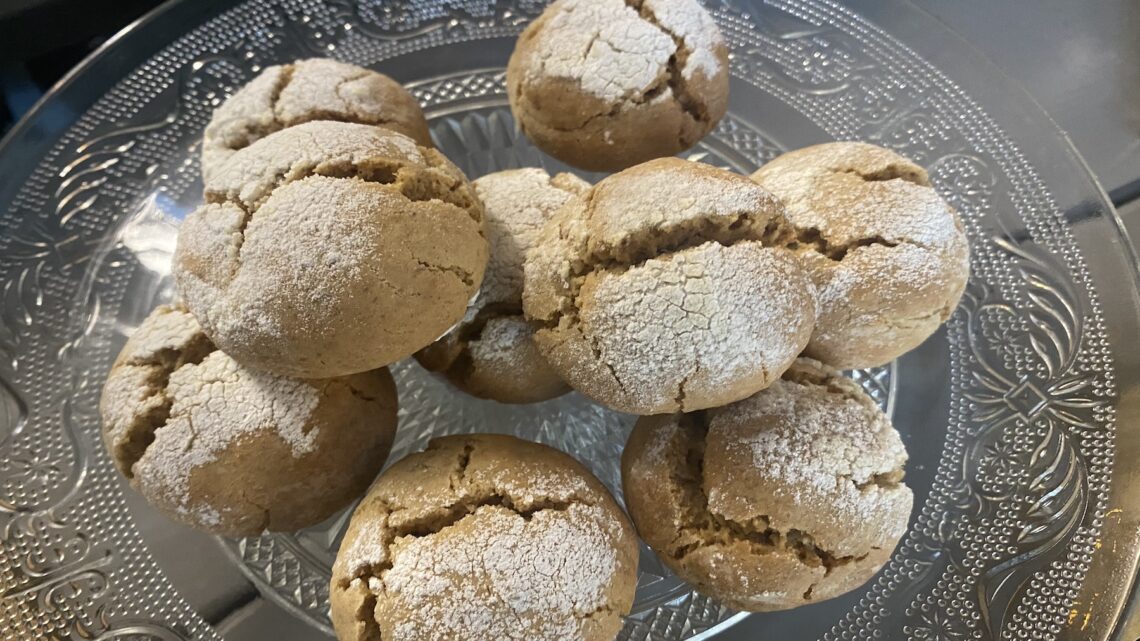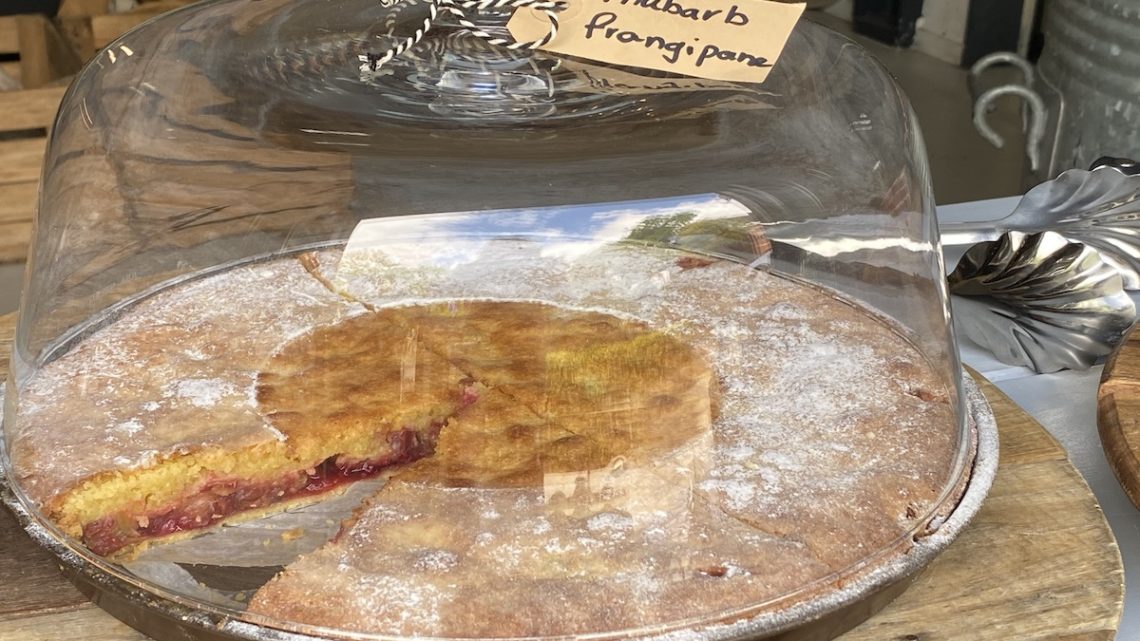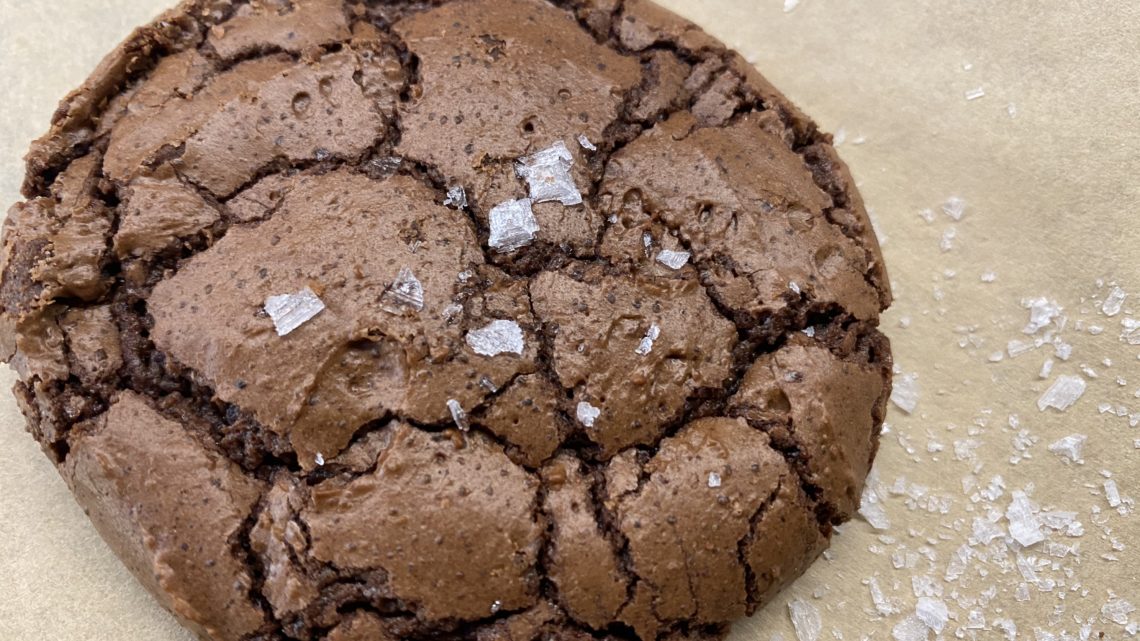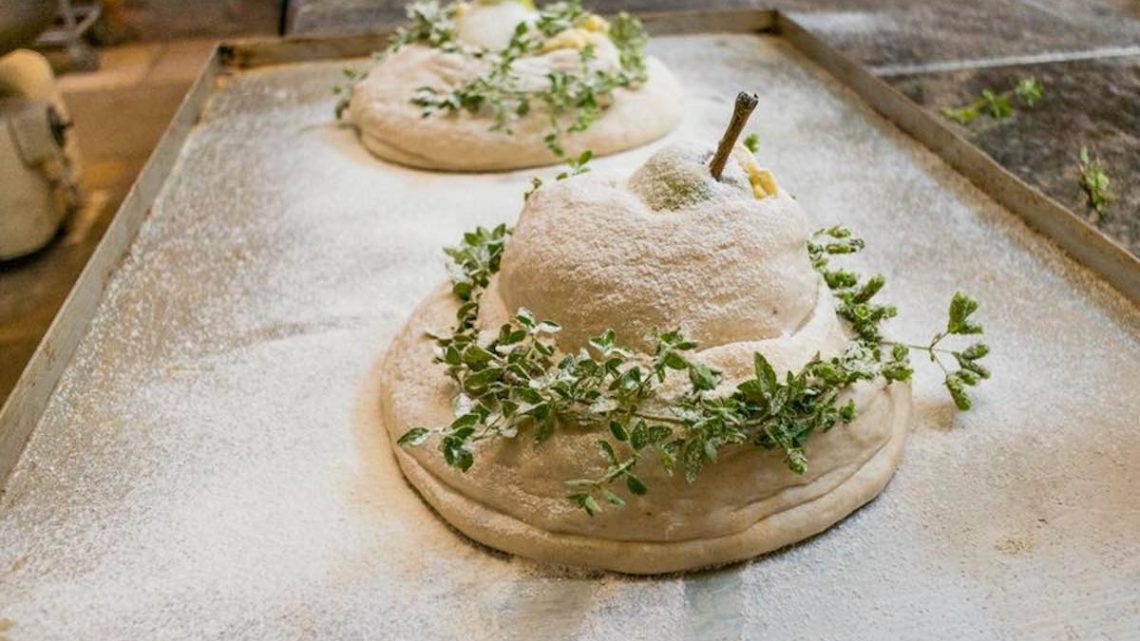Christmas crackle cookies
 Brown butter crackle cookies
Brown butter crackle cookies
INGREDIENTS
- 150G (5¼ OZ) UNSALTED BUTTER, CHOPPED
- 1¼ CUPS (200G/7 OZ) CSR RAPADURA SUGAR
- 2 EGGS
- 2 TEASPOONS VANILLA EXTRACT
- 2½ CUPS (385G/13½ OZ) WHITE WINGS PLAIN FLOUR
- 1 TEASPOON BAKING POWDER
- 1 TEASPOON GROUND CINNAMON
- CSR PURE ICING SUGAR, FOR ROLLING
METHOD
- Place the butter in a small saucepan over medium heat and cook until foaming. Whisk for 2–3 minutes or until the butter is a deep golden colour. Set aside to cool slightly
- Place the butter and rapadura sugar into the bowl of an electric mixer. Beat until combined. Add the eggs and vanilla and beat well. Sift over the flour, baking powder and cinnamon and beat on low speed until combined. Cover and refrigerate the cookie dough for 1 hour or until firm.
- Preheat oven to 180°C (350°F). Line 2 trays with non-stick baking paper.
- Sift icing sugar into a shallow bowl. Roll tablespoons of the cookie dough into balls, then roll in the icing sugar to coat.
- Place dough balls on prepared trays and bake for 10–12 minutes or until cookies are just golden and set. Set aside on trays to cool.Makes 26
Frangipane with rhubarb
Ingredients
Pastry
350 g flour
225 g butter
100 g powdered sugar
75 g egg yolks (± 3 egg yolks)
salt
Filling
225 g butter
225 g caster sugar
175 g ground almonds
50 g flour
4 eggs
3 tablespoons raspberry jam
1 kg rhubarb
demarara sugar, to taste
2 tablespoons grenadine
icing sugar, for dusting
Method
To make the dough, place the flour, powdered sugar and salt in a large bowl. Make a well in the middle and add the butter and egg yolks. Knead the butter and eggs to combine and then gradually incorporate the flour. If the pastry seems too dry, add extra egg yolk or a little cold water. Knead the pastry gently until soft but not sticky. Cover with plastic and place in the refrigerator for 30 minutes.
Roll the pastry out on a lightly floured surface to a thickness of 5 mm to line a tart tin of 20 cm in diameter.
Allow the pastry case to rest in the fridge for about an hour so that it won’t shrink on baking. Bake the pastry case blind – line the with a piece of baking paper or aluminium foil and fill with dried beans or rice. Place in preheated oven at 180°C for about 15 minutes or until the pastry is cooked. Remove the beans and paper or foil. Brush the pastry with an egg yolk return to the oven for another 5 minutes or until the pastry is golden.
Cut the rhubarb into 1 cm pieces, place on a roasting tray and sprinkle with demarara sugar to taste and 2 tablespoons grenadine. Roast at 200C for 10 minutes. Allow to cool.
To make the frangipane, beat the butter and sugar together in an electric mixer until light. Mix the ground almonds and flour together in a separate bowl. Add the eggs to the butter-sugar mixture, one at a time, followed by a spoonful of the almond-flour mixture. Once all the eggs have been added, add the brandy and remaining almond mixture.
Spoon the jam into the pastry case. Spoon the rhubarb in a single layer and spoon the almond filling on top. Bake in the oven for 30-35 minutes or until gilden brown and set. Allow the tart to cool in the tin. Dust with icing sugar before serving.
brownie crinkle cookie
We often get inspired by what we come across on social media. This is one such recipe we and really suggest you give it a try.
Makes 10 cookies
Ingredients
200g dark chocolate (around 65-70% cocoa solids), finely chopped
125g unsalted butter, diced
150g caster sugar
100g light brown sugar
2 large eggs
130g flour
3 tbsp cocoa powder
1 tsp baking powder
1/4 tsp salt (plus flaked sea salt for sprinkling)
Method
Temperature and timing is very important with this recipe so before you start get all the ingredients weighed out, two baking trays lined with baking paper and the oven preheated to 180C (160C fan).
Place the butter and chocolate into a heatproof bowl and set over a pan and gently simmering water. Allow to melt, stirring occasionally until fully melted. Remove the bowl from the heat and set aside for the moment. In the bowl of a stand mixer fitted with the whisk attachment, or using an electric hand mixer, whisk together the eggs and sugars for exactly 5 minutes. Once the eggs have been mixing for exactly 5 minutes pour in the chocolate mixture and mix for a minute or so to combine. Meanwhile mix together the dry ingredients, sieving the cocoa powder if it has lots of lumps. Add the dry ingredients and mix very briefly just until combined. Use your spatula to give one last mix, scraping the bottom of the bowl to make sure everything is evenly combined. Use a ice cream scoop to form the cookies. The batter will be a little on the wet side, so invert the cookie scoop just above the baking tray to avoid spills. Make sure to leave plenty of space between each cookie as they will spread. Sprinkle each cookie with a little flaked sea salt before placing into the oven and baking for 12 minutes. The cookies will come out of the oven with that wonderful crinkled look and slightly domed. They will collapse a little as they cool but this helps form that perfect fudgy centre. The cookies will be very soft so allow them to cool on the baking trays for at least 20-30 minutes before removing from the tray to cool completley.
These cookies will keep for 4-5 days but will be best within the first 3 days.
Lemon Cupcakes with Buttercream Icing
This recipe for lemon cupcakes is one that we have adapted from Martha Stewart. It produces light, tender cupcakes with a fragrant lemony flavour. Makes about 24 cupcakes.
Ingredients
3 cups flour
1 tablespoon baking powder
1/2 teaspoon salt
220g unsalted butter, at room temperature
2 cups caster sugar
4 large eggs
finely grated zest of 2 lemons and 2 tablespoons lemon juice
1 teaspoon vanilla extract
1/2 cup natural yoghurt
1/2 cup milk
Buttercream Icing
150g butter, softened
300g icing sugar
1-2 tablespoons milk
¼ teaspoon vanilla extract
Chopped chocolate or other decorations to garnish. Our favourite is to use different flavours from Tony's Chocolonely.
Method
Preheat an oven to 160C. Line a muffin or cupcake tin with paper cases. Mix together the flour, baking powder and salt.
Using an electric mixer, cream the butter and sugar together until pale and fluffy. Add the eggs, one at a time, beating until each is incorporated. Beat in the lemon zest and vanilla. Add the flour mixture in batches, alternating with the yoghurt, milk and lemon juice. Beat until just combined.
Divide the batter evenly among the cupcake cases, filling them about 3/4 full. Bake for about 25 minutes, rotating the tins halfway until the cakes are golden brown and a skewer inserted into the centre comes out clean.
Transfer to wire racks and cool completely before icing. The cupcakes can be stored in an airtight container of frozen.
For the buttercream, beat the butter in a large bowl until soft. Add half of the icing sugar and beat until smooth.
Add the remaining icing sugar and one tablespoon of the milk and vanilla extract and beat the mixture until creamy and smooth. Beat in the remaining milk, if necessary, to loosen the mixture.
Spread the icing over the cupcakes using a knife or small palette knife. Top with the chopped chocolate or other decorations of your choice.
Easy Cinnamon Buns
Cinnamon buns are everywhere at the moment. It takes time and patience to make your own which is definitely worth. However, we're all often short of time. If you want a quick fix but haven't go the time, try these easy cinnamon buns with ingredients available at any store.
Makes 12 buns
Ingredients
240 g can ready-made croissant dough
50g unsalted butter, softened
2 tsp cinnamon
6 tbsp soft dark brown sugar
Method
Heat oven to 170C. Line a 20cm cake tin with a square of baking paper so the corners stick up (this will help you to lift the buns out).
Unroll the croissant dough from the can and lay it out on your work surface. Cut it into three sections along the dotted lines, but don’t cut the diagonal line. Spread over half of the butter.
Mix the cinnamon and sugar together. Using one square of dough at a time, sprinkle over 2-3 tsp of the sugar and roll up the dough. When you have three rolls, cut each one in half and then each half in two. Arrange the rolls in the tin – they will rise and spread a little. Stick the end bits in among fatter pieces from the centre of the rolls so they cook evenly. Bake for 15-18 minutess or until the buns are risen and cooked through.
Meanwhile, heat the remaining sugar-cinnamon mix with the remaining butter until you have a thick caramel (don’t worry if some of the butter separates out, it will soak into the dough). If it's too grainy, add a little boiling water from the kettle to the it down and smooth it out.When the buns are cooked, brush over the caramel. Leave to cool a little, then eat warm.
Tuscan Bread
The first time you try Tuscan bread, it feels like someone must be playing a joke. This bland-tasting, pale-crusted bread surely can’t be right. But Tuscan bread it is! In fact, the bread is (quite deliberately) missing one key ingredient.
Tuscan bread is intentionally made without or with very little salt. Tuscan bread not only lacks depth of flavour without salt, the crust also doesn’t brown and the structure is much more delicate.
Salt-less Tuscan bread is really not intended for eating on its own. It’s usually served along with the main meal and is meant for sopping up thick, rich sauces. The bread doesn’t compete with the flavours in the dish, and both are enhanced.
1st Fermentation
35 g yeast
1 Tbsp flour
125 ml lukewarm water
1250 g flour
500 ml lukewarm water
pinch of salt
Method
1
1st fermentation – Dissolve the yeast in 125 ml lukewarm water. Add 1 tablespoon flour and leave to rise.
2
Place the flour in the bowl of a mixer, add the fermented mixture and the remaining 500 ml water. Add a little more water if necessary to get a soft but not sticky dough.
3
Mix all together and knead for 5 -10 minutes to a small ball.
4
Shape into an oblong and wrap in a cloth dusted with flour, leave to rise for 1 hour.
5
Carefully remove the bread from the cloth and place in a baking tray dusted with flour.
6
Bake in an oven, preheated at 180°C for about 50 minutes.
Homemade Pita Bread
Pita Bread
Makes 14 small or 10 large pita breads
Ingredients
500 g wheat flour, plus extra for dusting
25 g fresh yeast or 7 g instant dried yeast
15 g castor sugar
10 g salt
300 ml cold water
45 ml olive oil
Method
Place all the dry ingredients in the bowl of a mixer fitted with a dough hook. Mix all the ingredients and add the water and olive oil.
Knead for about 10 minutes on a low speed until the dough is elastic.
Place the dough on a wooden board, cover with a damp tea towel and allow to rise for about an hour or until doubled in size.
Dust the work surface with flour and cut the dough into 14 pieces of about 60 grams (for small pitas) or 10 pieces of about 80 grams (for large pitas).
Roll each portion of dough into a ball. Spread the dough balls over the work surface leaving enough space between them as they will expand. Cover once again with a damp tea towel and leave for about 20-20 minutes until they have doubled in size. In the meantime, preheat the oven to 240 C.
Roll the dough balls out with a rolling pin into circles with a 12 cm diameter for small pita breads and to 16 cm diameter for large ones. All the breads should be the same thickness so that they rise evenly in the oven.
Line 2 large baking trays with grease proof paper. Place on the dough circles and allow to rise for a further 10-15 minutes.
Bake the pita in the preheated oven for 8-10 minutes until well risen and ballooned. This usually means they are cooked through. To give them a good brown colour, you cam leave them in the oven for a further 1-2 minutes.
Remove the pita breads from the oven and place in a deep dish covered with a clean tea towel. This will ensure that the pita's get softer before serving.
Eyal Shani's World Famous Roasted Cauliflower and Pita Breads
Most of you have come across the whole roasted cauliflower in some form or another. It's actually the creation of famous Israeli chef, Eyal Shani. It's served in his restaurants in Israel and around the world.
Here is the definitive recipe as well as a recipe for traditional pita breads to have alongside. After making these, you'll never buy pita from the supermarket again.
Roasted Cauliflower
Ingredients
2 small cauliflower with leaves attached
extra virgin olive oil
coarse sea salt
Method
Preheat an oven to 250 C.
Bring a large pan of salted water to the boil. Use 2 teaspoons salt per liter of water. Place the cauliflower with their leaves still attached upside down in the pan and cook the cauliflower for about 10 minutes.
Drain the cauliflower and allow to stand for a minute or so until all the water has drained out. Rub your hands with a generous amount of olive oil and massage it into the cauliflowers, then sprinkle them with coarse salt.
Scrunch up 2 pieces of grease proof paper and shape into 'bowls' to go around the cauliflowers. Roast them in the preheated oven for 20-25 minutes so that the top gets dark and charred.
Remove from the oven and drizzle with a little extra olive oil. You can also sprinkle over a little extra salt if you wish. Serve the cauliflower in the baking paper with a bowl of tahini and pita bread on the side.
Pita Bread
Makes 14 small or 10 large pita breads
Ingredients
500 g wheat flour, plus extra for dusting
25 g fresh yeast or 7 g instant dried yeast
15 g castor sugar
10 g salt
300 ml cold water
45 ml olive oil
Method
Place all the dry ingredients in the bowl of a mixer fitted with a dough hook. Mix all the ingredients and add the water and olive oil.
Knead for about 10 minutes on a low speed until the dough is elastic.
Place the dough on a wooden board, cover with a damp tea towel and allow to rise for about an hour or until doubled in size.
Dust the work surface with flour and cut the dough into 14 pieces of about 60 grams (for small pitas) or 10 pieces of about 80 grams (for large pitas).
Roll each portion of dough into a ball. Spread the dough balls over the work surface leaving enough space between them as they will expand. Cover once again with a damp tea towel and leave for about 20-20 minutes until they have doubled in size. In the meantime, preheat the oven to 240 C.
Roll the dough balls out with a rolling pin into circles with a 12 cm diameter for small pita breads and to 16 cm diameter for large ones. All the breads should be the same thickness so that they rise evenly in the oven.
Line 2 large baking trays with grease proof paper. Place on the dough circles and allow to rise for a further 10-15 minutes.
Bake the pita in the preheated oven for 8-10 minutes until well risen and ballooned. This usually means they are cooked through. To give them a good brown colour, you cam leave them in the oven for a further 1-2 minutes.
Remove the pita breads from the oven and place in a deep dish covered with a clean tea towel. This will ensure that the pita's get softer before serving.
Pear bread
600 g - 1kg strong white bread flour
1 x 7 g sachet of dried yeast
300 g strong white bread flour
350 g strong white bread flour , plus extra for dusting
oil , for greasing
- For the starter, combine 200g of the flour with 200ml of lukewarm water in a non-metallic container – a glass jar is perfect. Leave it somewhere warm uncovered overnight.
- The following day, feed it by discarding half and adding a further 100g of flour and 100ml of lukewarm water.
- Repeat this feeding process each day until you see bubbles throughout the mixture (this is where a glass jar comes in handy). It will take a few days, possibly more, for the mixture to pick up the natural airborne yeasts and really start living. Don’t lose hope, it will happen!
- Removing 100g of the starter to make your loaf, chill the rest, covered but with a hole for it to breathe. You’ll need to feed this once a week – bring it up to room temperature first, allow it to bubble up, then recede (somewhere warm) for 30 minutes to 1 hour, then return it to the fridge within an hour or so. A liquid layer may develop on top, called hooch; stir it in if you like, or pour it off.
- To make the sponge, bring the 100g of starter up to room temperature.
- Combine the 300g flour and ½ teaspoon of sea salt in a bowl, then add 300ml of warm water and the starter.
- Cover with a towel and leave it to rise somewhere warm for 3 to 4 hours, or until doubled in size.
- In the meantime, top up the starter with 50g of flour and 50ml of lukewarm water (the weight you removed), allow it to bubble up and down as in step 3, then return it to the fridge.
- Either use your sponge straight away or chill it, covered, overnight.
- Now to make the sourdough bread. Bring the sponge up to room temperature (if needs be), combine it with the flour and 2 teaspoons of salt, then turn it out onto a floured surface.
- Knead for 10 minutes, or until smooth and elastic. Put the dough in a lightly oiled bowl, cover and leave to rise in a warm place for 2 to 3 hours, or until doubled in size.
- Tip the dough onto a floured surface, knock out the air, then shape it into a round loaf, placing the pear inside on an oiled baking sheet.
- Wrap the thyme around as crown, over and prove for about 1 hour in a warm place, or until it doesn’t spring back when prodded.
- Preheat the oven to 220°C.
- When the dough is ready, place a tray of water in the base of the oven (this will help it develop a good crust) and score the top of the loaf with a sharp knife.
- Bake for 30 to 40 minutes until golden and sounds hollow when tapped. Cool on a wire rack.
Delicious served with blue cheese.
Madeleines
Matcha (green tea) Madeleines
Makes about 12
Ingredients
100g caster sugar
100g flour
1 egg
Lemon zest and juice of ½ lemon
¾ teaspoon baking powder
½ teaspoon matcha powder
100g butter and some extra for greasing the tin
Method
1 Preheat oven to 200 C˚. Melt the butter in a small pan and grease the baking tin. Sprinkle lightly with some flour, shaking off the excess. Mix the dry ingredients together.
2 Whisk the eggs and sugar in a bowl until light and fluffy. Fold the dry ingredients carefully carefully through the beaten eggs followed by the melted butter. Let stand for 15 minutes.
3 Fill each mold in the Madeleine baking tin ¾ full with the batter. Bake in the oven for 8-9 minutes or until cooked through. Leave them to cool for 1 minute in the tin and then gently remove. Put them on a rack to cool and sprinkle with icing sugar.










